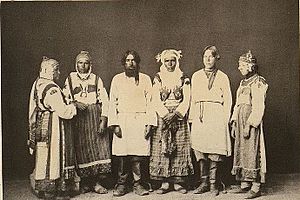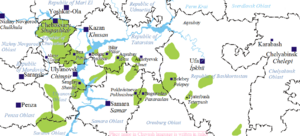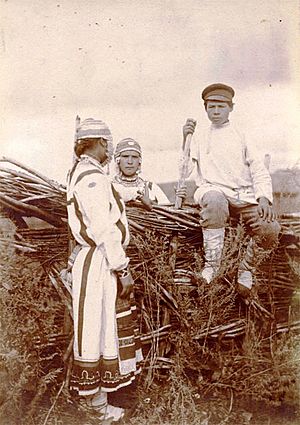Chuvash people facts for kids
| чӑвашсем çăvaşsem |
|
|---|---|

Unbaptized Chuvash people (1870).
|
|
| Total population | |
| c. 1.5 million | |
| Regions with significant populations | |
|
1,435,872 684,930 |
| 22,305 | |
| 10,593 | |
| 10,074 | |
| 3,904 | |
| 2,281 | |
| 2,242 | |
| 1,204 | |
| 900 | |
| 848 | |
| 542 | |
| 466–518 | |
| 489 | |
| 373 | |
| Languages | |
| Chuvash Russian |
|
| Religion | |
| Majority: Minority: |
|
| Related ethnic groups | |
| Volga Tatars, Volga Finns, Besermyan | |
The Chuvash people are a group of people who are part of the Turkic peoples. They originally come from the Volga-Ural region in Russia, stretching towards Siberia. Most Chuvash people live in a place called Chuvashia and the areas around it. However, you can find Chuvash communities all over Russia. They speak the Chuvash language, which is a special Turkic language that became different from other Turkic languages a very long time ago. Most Chuvash people who follow a religion are Eastern Orthodox Christians.
Contents
What Does "Chuvash" Mean?
Nobody knows for sure where the word Chuvash came from. But there are three main ideas.
One popular idea, which many Chuvash people believe, is that Chuvash comes from the word Suvar. The Suvar people are thought to be the ancestors of today's Chuvash.
Another idea is that the word Chuvash might mean 'friendly' or 'peaceful'. This is seen as the opposite of 'warlike'. A third idea connects the word to the Tabghach, an old clan from China.
The Chuvash Language
The Chuvash language is part of the Turkic languages family. It is the only surviving language from a special group called Oghur Turkic. People speak Chuvash in Chuvashia and nearby areas along the Volga River in Russia.
The Chuvash language is unique because it is very different from other Turkic languages. Some experts even thought it might be related to Uralic languages at one point. This is because it has some sounds and grammar rules that are not common in other Turkic languages.
The Tatar language, the nearby Mari language, and the Russian language have all influenced the Chuvash language. Chuvash has a few different ways of speaking, called dialects. These are:
- Virjal (meaning 'upper')
- Anat jenchi (meaning 'mid-lower')
- Anatri (meaning 'lower')
- Hirti (meaning 'steppe') – some researchers also recognize this group.
History of the Chuvash People
Where Did They Come From?
There are two main ideas about where the Chuvash people came from. One idea is that they are a mix of the Suar and Sabir tribes from a place called Volga Bulgaria. Some research also suggests they mixed with Volga Finns. The other idea is that the Chuvash might be related to the Khazars, based on their language and family connections.
The people most closely related to the Chuvash are believed to be the Volga Bulgars. Over time, the Chuvash people were also influenced by Russians, other Turkic groups, and neighboring Finnic tribes.
Early Times
The ancestors of the Chuvash, the Sabirs, are thought to have come from Western Siberia. They were known for being good fighters and skilled boat builders.
Around the first century AD, a group called the Bulgars began moving west. They reached the North Caucasus region in the 2nd and 3rd centuries AD. Here, they formed several states. One of these, Old Bulgaria, broke apart in the 7th century after attacks from the Khazars.
The Sabirs, who were part of the Khazar Khanate, later moved to the Volga-Kama area. They helped create Volga Bulgaria, which became a very rich state. Its capital city was once one of the largest in the world.
Later, the Mongols attacked and destroyed Volga Bulgaria in 1236. The Golden Horde then controlled the region until about 1438. After that, the Khanate of Kazan took over. The name "Chuvash" started appearing in records from the 16th century.
In 1552, the Russians conquered the Kazan Khanate. The Chuvash people had to pay taxes and slowly lost much of their land. Many who were farmers had to work in the timber industry or on boats because they became very poor. Over the next centuries, the Chuvash people were encouraged to become Christians and adopt Russian ways. Most Chuvash became Orthodox Christians, but they kept some of their own traditions.
Modern History
The 18th and 19th centuries saw a rebirth of Chuvash culture. Many books and educational materials were published. Schools were started, and the Chuvash language began to be used in local schools. A special writing system for Chuvash was created in 1871.
On June 24, 1920, the government of Russia created the Chuvash Autonomous Region. It became the Chuvash Autonomous Soviet Socialist Republic in 1925. During this time, Chuvash nationalism grew. However, the Soviet government tried to stop these movements. They changed the borders of the republic, which meant many Chuvash people ended up living outside their main area. For most of the Soviet period (1917–1991), the Chuvash were encouraged to become more like Russians.
The Chuvash language was used less in schools and public life. But in 1989, another Chuvash cultural revival began. This was partly a response to these changes. Soon, the Chuvash language was used again in education, public life, and politics. Today, schools in the Chuvash Republic teach the Chuvash language and culture. Chuvash people across Russia also have media in their own language.
Chuvash Genetics
Scientists who study human genetics have looked at the Chuvash people. Early studies in the 20th century suggested they were a mix of Finno-Ugric and Turkic peoples. More recent studies in 2015 and 2017 found that modern Chuvash people have ancestors from both Oghur (Turkic) and Finno-Ugric groups. This means that while their language is Turkic, their genetic makeup shows a strong connection to Finno-Ugric people as well.
One study found that Chuvash people have a genetic link between Northeastern Europe and Western Siberia. This shows their unique history and location.
Chuvash Culture
The Chuvash people speak the Chuvash language. They also have some traditions that come from before Christianity. Their traditional clothes often feature special patterns in embroidery. Many Chuvash people also speak Russian and Tatar.
Chuvash Religion
Most Chuvash people are Eastern Orthodox Christians. They belong to the Russian Orthodox Church. A smaller number are Sunni Muslims or follow an old Chuvash religion called Vattisen Yaly.
After Russia took control of the Chuvash lands in the 16th century, efforts began to convert them to Christianity. However, most Chuvash did not become Christian until the mid-19th century. Even after converting, the Chuvash kept some of their old traditions from before Christianity and Islam. These traditions are similar to shamanism.
Some Chuvash people might have learned about Islam during the time of Volga Bulgaria. Many of those who became Muslim likely did so during the Golden Horde period. There is an old writing from 1307 that says some Chuvash became Muslim. Some Chuvash who first became Christian after the Russian conquest later converted to Islam in the 19th and early 20th centuries.
Some Chuvash people still pray at special shrines called keremet and offer geese there. Vattisen Yaly is a modern movement that aims to bring back the old ethnic religion of the Chuvash people.
See also




